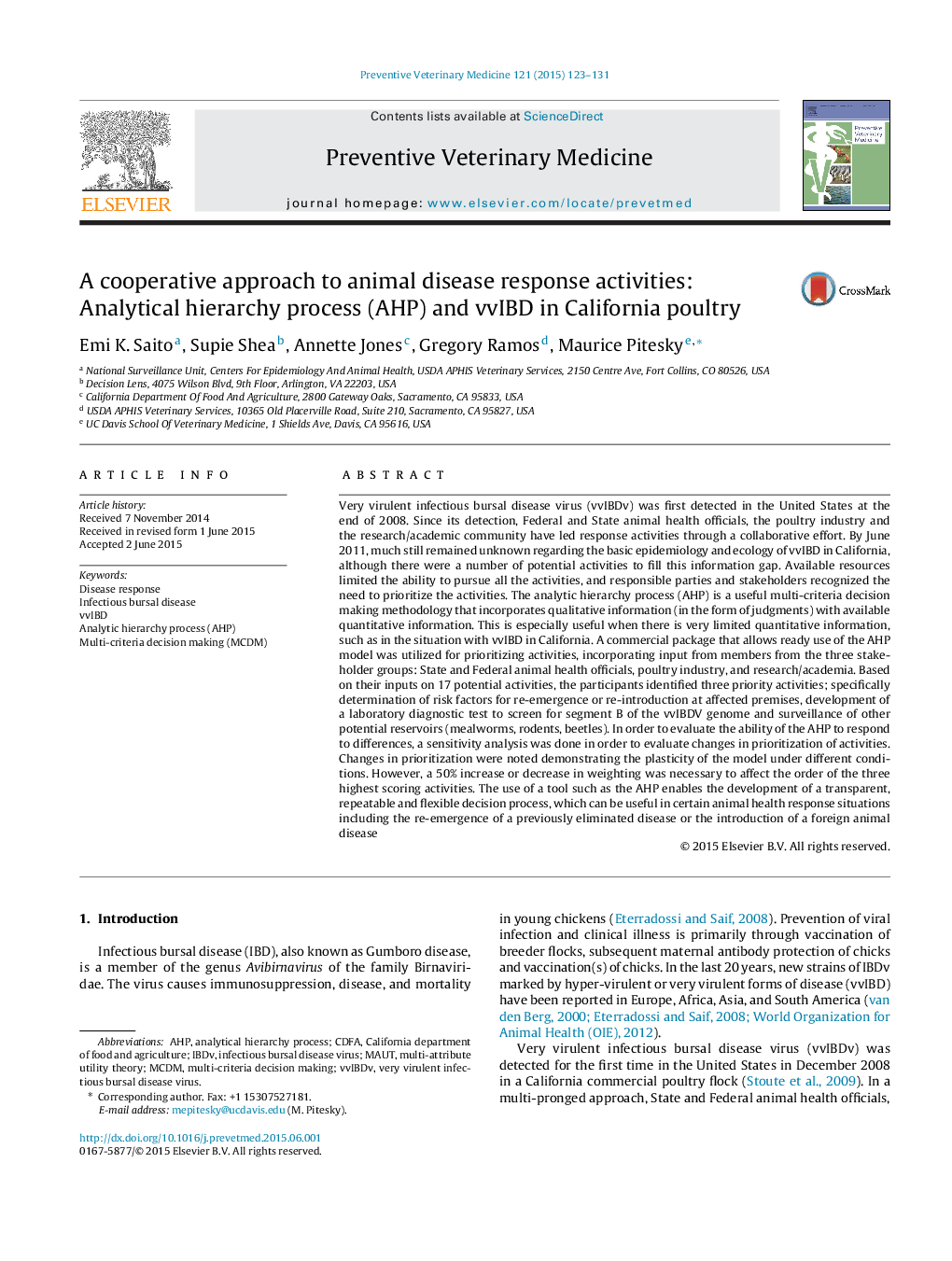| کد مقاله | کد نشریه | سال انتشار | مقاله انگلیسی | نسخه تمام متن |
|---|---|---|---|---|
| 5793033 | 1554168 | 2015 | 9 صفحه PDF | دانلود رایگان |
عنوان انگلیسی مقاله ISI
A cooperative approach to animal disease response activities: Analytical hierarchy process (AHP) and vvIBD in California poultry
دانلود مقاله + سفارش ترجمه
دانلود مقاله ISI انگلیسی
رایگان برای ایرانیان
کلمات کلیدی
MAUTCDFAvvIBDVIBDVMCDMInfectious bursal disease - بیماری بروس عفونیMulti-attribute utility theory - تئوری ابزار چند ویژگیMulti-criteria decision making - تصمیم گیری چند معیارهMulti-Criteria Decision Making (MCDM) - تصمیم گیری چند معیاره (MCDM)Analytical hierarchy process - روند سلسله مراتب تحلیلیAnalytic Hierarchy Process (AHP) - روند سلسله مراتب تحلیلی (AHP)AHP - فرایند تحلیل سلسلهمراتبیInfectious bursal disease virus - ویروس بیماری بروس عفونیDisease response - پاسخ بیماری
موضوعات مرتبط
علوم زیستی و بیوفناوری
علوم کشاورزی و بیولوژیک
علوم دامی و جانورشناسی
پیش نمایش صفحه اول مقاله

چکیده انگلیسی
Very virulent infectious bursal disease virus (vvIBDv) was first detected in the United States at the end of 2008. Since its detection, Federal and State animal health officials, the poultry industry and the research/academic community have led response activities through a collaborative effort. By June 2011, much still remained unknown regarding the basic epidemiology and ecology of vvIBD in California, although there were a number of potential activities to fill this information gap. Available resources limited the ability to pursue all the activities, and responsible parties and stakeholders recognized the need to prioritize the activities. The analytic hierarchy process (AHP) is a useful multi-criteria decision making methodology that incorporates qualitative information (in the form of judgments) with available quantitative information. This is especially useful when there is very limited quantitative information, such as in the situation with vvIBD in California. A commercial package that allows ready use of the AHP model was utilized for prioritizing activities, incorporating input from members from the three stakeholder groups: State and Federal animal health officials, poultry industry, and research/academia. Based on their inputs on 17 potential activities, the participants identified three priority activities; specifically determination of risk factors for re-emergence or re-introduction at affected premises, development of a laboratory diagnostic test to screen for segment B of the vvIBDV genome and surveillance of other potential reservoirs (mealworms, rodents, beetles). In order to evaluate the ability of the AHP to respond to differences, a sensitivity analysis was done in order to evaluate changes in prioritization of activities. Changes in prioritization were noted demonstrating the plasticity of the model under different conditions. However, a 50% increase or decrease in weighting was necessary to affect the order of the three highest scoring activities. The use of a tool such as the AHP enables the development of a transparent, repeatable and flexible decision process, which can be useful in certain animal health response situations including the re-emergence of a previously eliminated disease or the introduction of a foreign animal disease
ناشر
Database: Elsevier - ScienceDirect (ساینس دایرکت)
Journal: Preventive Veterinary Medicine - Volume 121, Issues 1â2, 1 September 2015, Pages 123-131
Journal: Preventive Veterinary Medicine - Volume 121, Issues 1â2, 1 September 2015, Pages 123-131
نویسندگان
Emi K. Saito, Supie Shea, Annette Jones, Gregory Ramos, Maurice Pitesky,